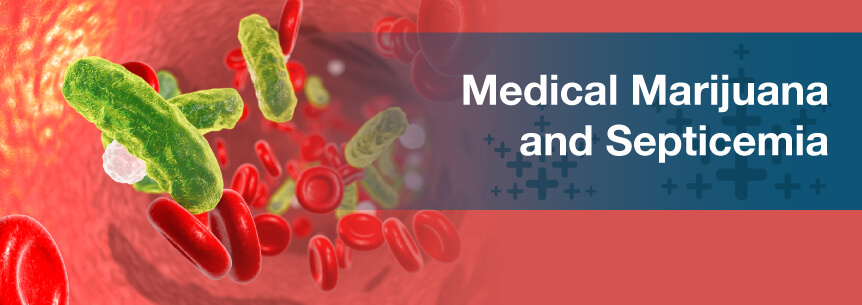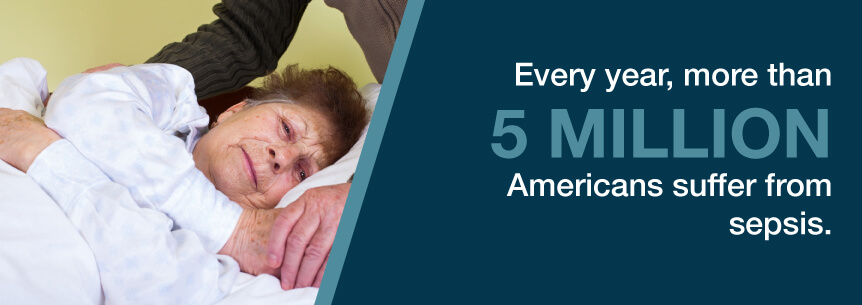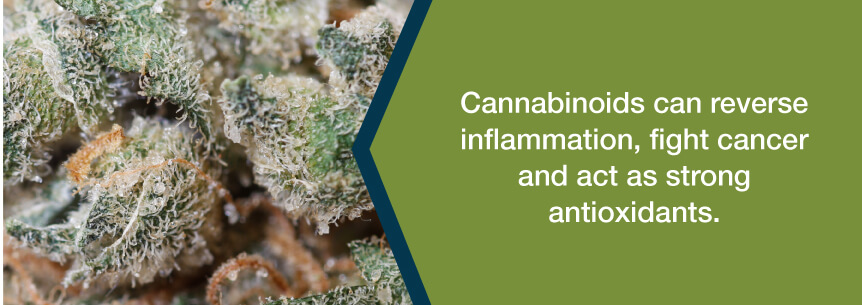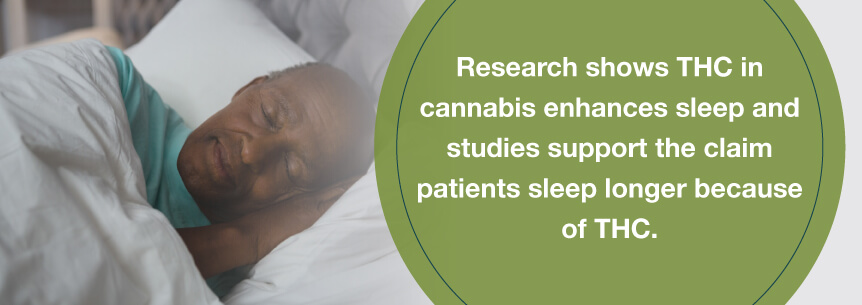
For a long time, minor injuries and common infections have been treatable. However, now they’re once again causing death worldwide. A top health concern today is antibiotic-resistant bacteria causing unmanageable infections. The good news is, studies of medical marijuana for septicemia are now showing much promise.
Septicemia is a serious infection of the bloodstream. Doctors also refer to it as blood poisoning and bacteremia. It occurs when different parts of your body, like your skin or lungs, develop a bacterial infection entering your bloodstream. When this happens, it’s dangerous, since your bloodstream can carry the toxins and bacteria throughout your entire body.
If you don’t have septicemia treated in a hospital, it can become life-threatening quickly. It can also turn into sepsis.
Sepsis and septicemia are not technically the same thing, though they are very closely related and people use the terms interchangeably at times. Sepsis is a septicemia complication and involves inflammation in your body. The inflammation may block oxygen from reaching your organs and lead to organ failure. It can also cause blood clots. In other words, septicemia is the infection, while sepsis is the body’s inflammatory response to the infection. Some people refer to the condition as “blood poisoning.”
Each year, more than 1 million individuals in the U.S. get severe sepsis, according to the National Institutes of Health. And around 28 to 50 percent of these individuals can die from sepsis. When you have very low blood pressure along with inflammation, it’s called septic shock. In many cases, septic shock is deadly.
An infection in another area of your body causes septicemia. This is usually a severe infection. Various forms of bacteria can result in septicemia. Doctors may not be able to determine the infection’s exact source.
Common infections potentially resulting in septicemia include:
Bacteria come from these infections and enter your bloodstream. They then quickly multiply, which causes immediate symptoms.
You have a higher risk of septicemia if you:
You’re also at a higher risk if you’re already in the hospital for another reason. When in the hospital, secondary infections may occur. These are typically more dangerous, since the bacteria could be antibiotic-resistant already.
Diagnosing septicemia is a substantial challenge doctors face. It can often be hard for them to identify the infection’s exact cause. They usually need to run a whole range of tests.
Your physician will assess the symptoms you’re experiencing and question you about your medical history. They will give you a physical exam to check for body temperature and low blood pressure. They’ll also look for signs of other disorders known to occur with septicemias, such as cellulitis and meningitis.
Your physician will likely want to do some testing on different fluid types to help them confirm the bacterial infection. The tests may include:
They’ll likely check your platelet and cell counts and order specific tests for analyzing your blood clotting. They may also check the carbon dioxide and oxygen levels in your blood if you’re having difficulties breathing.
Doctors have classified three types of septicemia.
The history of septicemia dates back to the history of sepsis, which, as mentioned, is the life-threatening complication of septicemia. Although you may associate the word sepsis with modern intensive care, its medical perception is much older. Hippocrates — ca. 460-370 BCE — was first to introduce the term “sepsis,” derived from “sipsi,” the Greek word for “make rotten.” In the 17th century, a doctor in Leyden, Herrmann Boerhave, believed the cause of sepsis was airborne toxic substances.
In the early 19th century, Justus von Liebig, a chemist, broadened the theory by stating the contact between oxygen and wounds caused sepsis. Obstetrician Ignaz Semmelweis was the first to develop a modern view of sepsis, and published his research in 1863.
Septicemia symptoms tend to start rather fast. Even in the condition’s first stages, you can look incredibly sick. The symptoms of septicemia may follow surgery, an injury or another localized infection, such as pneumonia. The initial symptoms you may experience include:

You’ll then likely experience more severe symptoms as the untreated septicemia progresses. These severe symptoms include:
If you’re showing signs of septicemia, go directly to the hospital immediately. Don’t take the “wait-and-see” approach, and never try to treat yourself at home.
If left untreated or treated improperly, sepsis may cause organ failure, tissue decay or even death. At the time of diagnosis, patients with sepsis and no sign of organ failure have about a 15 to 30 percent chance of dying. The elderly have the highest mortality rates, and patients with severe sepsis or septic shock have a 40 to 60 percent chance of death.
If you survive septicemia, it could leave you in serious condition for weeks, with a long recovery period after that. The organs affected, the nature of your infection and how quickly you receive treatment will determine your recovery period.
Lasting sepsis effects include:
One study published in the Journal of the American Medical Association showed older adults who had severe sepsis and survived had a higher risk of developing cognitive problems and functional disabilities than other hospitalized adults. Sepsis patients, after their infection, also needed more help with everyday activities like getting dressed and walking than those who were hospitalized, but didn’t have sepsis.
Sepsis usually strikes when you’re in the hospital for an infection of the gut, lungs, skin, etc. When it occurs, it can prolong and worsen existing health issues seriously. Illness keeps you in bed most of the time and unable to participate in activities you once enjoyed.
Depression then sets in. When you’re restricted to your home or in a hospital bed, it can leave you feeling hopeless.
Most statistics about septicemia revolve around sepsis. The Centers for Disease Control and Prevention reports the following facts about sepsis:

If your septicemia is beginning to affect your tissue function or organs, it’s a medical emergency. You need to receive treatment at a hospital. Many individuals with septicemia end up in the ICU of a hospital for treatment and recovery.
The treatment you receive will depend on certain factors such as:
Doctors usually prescribe antibiotics to treat the septicemia causing the bacterial infection. Doctors often don’t have enough time to determine which bacteria type is causing the infection. Because of this, they usually start off prescribing “broad-spectrum” antibiotics, which fight off a whole range of bacteria all at once. If they determine the exact bacterium, they’ll prescribe a more specific antibiotic.
The doctor may give you other medications intravenously to prevent the formation of blood clots and maintain your blood pressure. You’ll also get fluids and probably an oxygen ventilator or mask if you’re having breathing difficulties because of your septicemia.
You could prevent the bacteria from getting into your bloodstream if antibiotics effectively treat your infection in its early stages. You can protect your children from the infection by making sure they stay current on their vaccinations.
If you have a compromised immune system, you can take the following measures to try and prevent septicemia:
Your endocannabinoid system helps regulate physiological functions, particularly your immune system. It shows promise in being involved in developing new treatments for sepsis. In fact, scientists have found manipulating the endocannabinoid system can save patients’ lives. It’s well-known that marijuana helps in preventing and treating inflammation.
The Department of Pharmacology, School of Pharmacy at Second Military Medical University in Shanghai, China, conducted a study in 2013 showing cannabis protects against sepsis when it activates your body’s cannabinoid receptors.
The researchers used mice as test subjects in the study, which was published in the journal Mediators of Inflammation. They found CB2 receptor activation could extend sepsis patients’ survival rates due to decreasing serum proinflammatory cytokines. The study found all data combined indicated CB2R offers protection and may just be a therapeutic sepsis target.

Cannabinoids come from the marijuana plant and have a whole range of medicinal properties. They can reverse inflammation, fight cancer and act as strong antioxidants.
Some side effects medical cannabis for septicemia helps treat include:
Many studies found weed to be an effective antiemetic therapy to relieve nausea and vomiting more effectively than various other medications, and without the harmful side effects. Along with pain and inflammation, nausea is among the three main symptoms of septicemia marijuana treats effectively.
Chronic pain is often so debilitating patients usually reach for strong opioid narcotics for relief. However, not only are these medications highly addictive, but they’re also toxic. Medical pot for chronic pain is a much safer and more effective treatment than opioids.

Research shows THC in cannabis enhances sleep. Studies support the claim patients sleep longer because of THC. It also helps decrease how much time it takes for them to fall asleep, while promoting deeper sleep.
Medical cannabis also serves as a natural alternative to depression and anxiety medication without the harsh side effects. It treats anxiety disorder and depression symptoms effectively, and many patients have found relief.
Marijuana for septicemia, as mentioned, is effective in treating your symptoms. You’ll want to find strains able to tackle your pain, nausea, depression and trouble sleeping. And many strains are helpful for various symptoms, including:
Strains for Pain
Strains for Nausea
Strains for Depression
Strains for Sleep
Your marijuana doctor and experienced budtender at your cannabis dispensary can help you choose the best strain or combination of strains that work best for you.
When it comes to marijuana and septicemia treatment consumption, after the plant itself, the second vital consideration is the delivery method. Gaining the physical and mental benefits of marijuana is hugely dependent on how you consume it, and each delivery method has its own unique experience and effects.
Some common methods of administering your cannabis and septicemia treatment include the following.
Now that you’re informed about cannabis for septicemia, it’s time to get the recommendation from your doctor. We offer you a convenient means to search for a doctor on MarijuanaDoctors.com. Marijuana Doctors gets you connected and lets you book appointments with qualifying licensed doctors who are thoroughly knowledgeable about medical cannabis and its therapeutic benefits to patients with medical conditions.
Once you find your doctor with us, you can browse for a medical marijuana dispensary right on our website. And we have a multitude of other resources, including in-depth articles and information on treatable conditions. to learn more about the benefits of medical cannabis. Get started with your search today.
Find A Doctor Find A Dispensary